ScaleTrains Union Pacific GTEL “Big Blow” Turbine
Published: 2023-07-03 - By: CNW400
Last updated on: 2023-07-03
Last updated on: 2023-07-03
visibility: Public - Headline
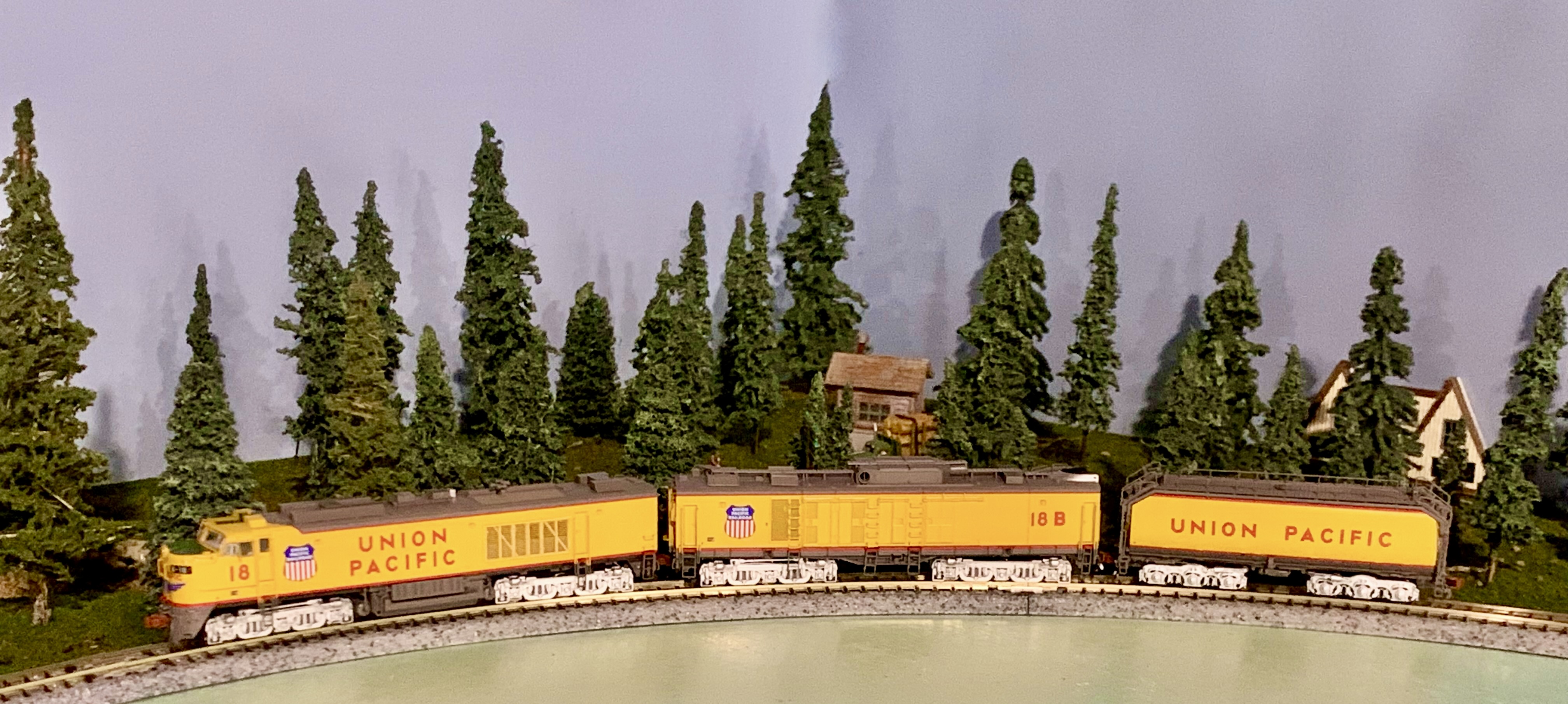
The Prototype
Seeking an alternative from steam and diesel-electric locomotives to haul longer and heavier trains through the Western Great Plains, Union Pacific Railroad began to experiment with steam turbine power around 1939. This experiment with steam proved unsuccessful, yet Union Pacific was never a company to shy away from innovation and turned to gas-turbine muscle during the late 1940s.
The first gas-turbine was designed and built through a partnership between the American Locomotive Company (ALCO) and General Electric (GE) in 1948. The prototype – a single unit with cabs located at both ends (the only turbine locomotive constructed this way) – left the General Electric Plant in Erie, Pennsylvania painted in Union Pacific colors with road number 50 and the soon to be christened nickname of ‘Messy Bessie’ because of fuel leaks and filthy emissions. Bessie was rated at 4500 horsepower with two turbines connected to four electrical generators that supplied electricity to motors mounted on the axles. She was initially tested with diesel fuel, but Union Pacific quickly switched to Bunker C fuel oil. Bunker C was a cheaper fuel choice considering that the turbine locomotive fuel economy performance was poor - consuming twice as much fuel as a diesel engine. Bunker C is the residual oil remaining when the lighter products, such as gasoline and kerosene, are distilled for crude oil. It is highly viscous with many impurities – one of the lowest grades of oil. Besides its cost advantage, the ‘heavy’ fuel has large molecules that supplies a superior output of energy per unit of fuel than other kinds. Bessie was comprehensively tested between 1948 and 1951...covering over 101,000 miles on Union Pacific mainline routes. Her 4500-horsepower proved to have three-times greater output than diesel engines from this era.
Impressed with their hauling power, the Union Pacific ordered 25 gas-turbine locomotives that were delivered between 1952 and 1954 (units 51 thru 75). The First-Generation turbine locomotives (units 51-60) were single units equipped with both a 250-horsepower diesel engine and a 4500-horsepower turbine with a 7200-gallon Bunker C fuel tank. The diesel engine handled the auxiliaries and yard movements without the need to start the turbine. These locomotives were 80-feet long and weighed over 550,000 pounds. With a maximum operating speed of 65mph, the gas-turbine had a range of 400 miles. They were often teamed with a Union Pacific Big Boy or Challenger steam engine to add extra pulling power for heavy trains. The locomotives were called ‘Big Blows’ for their deafening jet-like engine exhaust roar – the loud sounds had their use banned in some locales. The Union Pacific was the sole railroad in the United States to own gas-turbine locomotives with a fleet that totaled fifty-five units before their retirement in 1970. With them primarily running in the wide, open spaces between Council Bluffs, Iowa and Green River, Wyoming – the noise and nasty exhaust were not much of a problem at the inception of their existence.
The Second Generation (units 61-75) began to be delivered in 1954. Dubbed the Veranda series with the addition of external walkways, this Generation varied little elsewhere other than the inclusion of dynamic brakes. During 1955 and 1956, fuel tenders were added to the rear of all turbines. These 24,000-gallon tenders were converted from tenders used on the Union Pacific FEF 4-8-4 steam locomotives. The gas-turbine units were so valuable to the Union Pacific that the GTELs carried more than 10% of the railroad’s freight at the peak of their online usage.


In 1955, Union Pacific placed an order for the newly designed turbine locomotive. These Third-Generation turbines started to hit the rails in 1958 (numbered 1-30), the world’s most powerful locomotive of their time at 8500 horsepower and were comprised of three pieces of equipment: two units plus a fuel tender. The A-unit held the operator cabin and an 850 horsepower Cooper-Bessemer diesel engine. The 8500 horsepower “Super Turbine” (which according to some resources was actually rated at 10,000 but ran at a lower horsepower for fear of blowing the electrical systems) was located in the B-unit with the generating equipment. The 24,000-gallon (about the volume of a one car garage) tenders were fitted with electric heating elements to warm the fuel to a free-flowing temperature of 200°F. These turbines ran on a refined version of Bunker C fuel developed by the Richfield Oil Company. The configuration measured a whopping 179-feet long and weighed nearly 850,000 pounds. Supplementary diesel engine locomotives were latched-on when additional power was desired. These “Bird Burner” turbines still ran at a speed of 65mph.
By the late 1960s, the allure for the gas-turbine locomotives started to wane. The turbines had a great thirst for fuel – burning 600 gallons of fuel per hour. At first, this inefficiency was offset by the inexpensive cost of Bunker C fuel. But as crude oil refinery processes were improved, the lower grades of oil became cleaner and began to be coveted more by the plastics industry. This resulted in a price increase for Bunker C and contributed to the turbines falling victim to the more fuel-efficient diesel locomotives. Furthermore, maintenance expenditures became too great...the low-grade fuel was abrasive to fan blades, pump nozzles, heating equipment, and combustion chambers. Costly separate maintenance facilities and staff had to be maintained – add to that noise complaints, grimy exhaust blackened units, and environmentally unsafe nitrogen-oxide emissions. All of these factors led to the downfall of the mighty Union Pacific Gas-Turbine Electric Locomotive (GTEL). The last gas-turbine ran on December 26,1969 and all turbines were officially retired from revenue service in February 1970.

Of the 55 gas-turbines manufactured – 53 were scrapped but their running gear and trucks were reused for the GE U50 and GE U50C models. Many tenders were converted to Maintenance of Way (MOW) equipment and later used with Union Pacific’s preservation of steam locomotives UP 844 and UP 4014. Two Third Generation gas-turbines did survive the scrapyard – both have been cosmetically restored but are incomplete and non-operational: Union Pacific #18 has been displayed at the Illinois Railway Museum in Union, Illinois since 1993 and Union Pacific #26/#26B are found at the Utah State Railroad Museum in Ogden, Utah. Union Pacific #18’s tender was originally built in 1937 as UP #907853 for the FEF stream locomotive series. After its retirement from turbine usage in 1970 it was part of the Expo ‘74 (World’s Fair of 1974 held in Spokane, Washington) and American Freedom Train (1975-76) steam locomotive trains.

Road Numbers and Pricing
The ScaleTrains Union Pacific ‘Big Blow” Turbines are included in their N Scale Rivet Counter collection – models for the most discerning collector. Meticulous attention to the most minute detail – highly researched and skillfully constructed with an abundance of hand-applied parts and pieces. Not merely a toy, but truly a craftsman specimen of railroad history.Most recent ScaleTrains GTEL 8500 Horsepower “Big Blow” Turbine Release: October 28, 2022, 3-Unit Set (A-unit / B-unit / Fuel Tender)
- #1 Run with Challengers and Big Boys
- #6 “B” Dual Dynavane
- #10
- #16
- #18 Illinois Railway Museum Edition (2nd Release)
- #26 Utah State Railroad Museum Edition (2nd Release)
- #30 “B” Dual Air Intake Tubes
Sets were released with a suggested retail price of $699.99 for the DCC/Sound version and $461.99 for the DC/DCC-Ready version. The DCC models are equipped with an ESU LokSound 5 DDC/Sound decoder with ‘Full Throttle’ feature in both the A & B units. These DCC units include prime mover, turbine, and Leslie air horn sounds – amongst other sounds and noises.
As of July 2023 – the entire ScaleTrains Turbine family includes 21 different road numbers since its introduction in 2017. Road Numbers made available thus far: 1, 5, 6, 7, 9, 10, 13, 14, 15, 16, 18, 20, 21, 26, 27, 30, 51, 52, 54, 55 & 57.
My review includes observations of Union Pacific #18 – released in October 2022.
The Model
The three-piece set comes packaged in an eye-catching thick red and white cardboard box that measures 9.5” x 10.5” x 2.5.” Beautiful graphics on the front and tons of useful model information on the back panel. Once the cover is lifted open and a thin foam sheet is removed, the gas-turbine model set is revealed - snuggled in a two-inch thick foam cushion and wrapped inside a transparent plastic clamshell case. I am certain ScaleTrains has a technical explanation of how these clamshells protect the delicate pieces during shipping – but I am not a fan of this innovation. I find it too difficult to unwrap and rewrap the pieces for storage without the fear of damaging the models. Furthermore, a twenty-three-page large sized booklet is included filled with diagrams, history, and directions. The overall presentation is stellar – do not like the clamshell.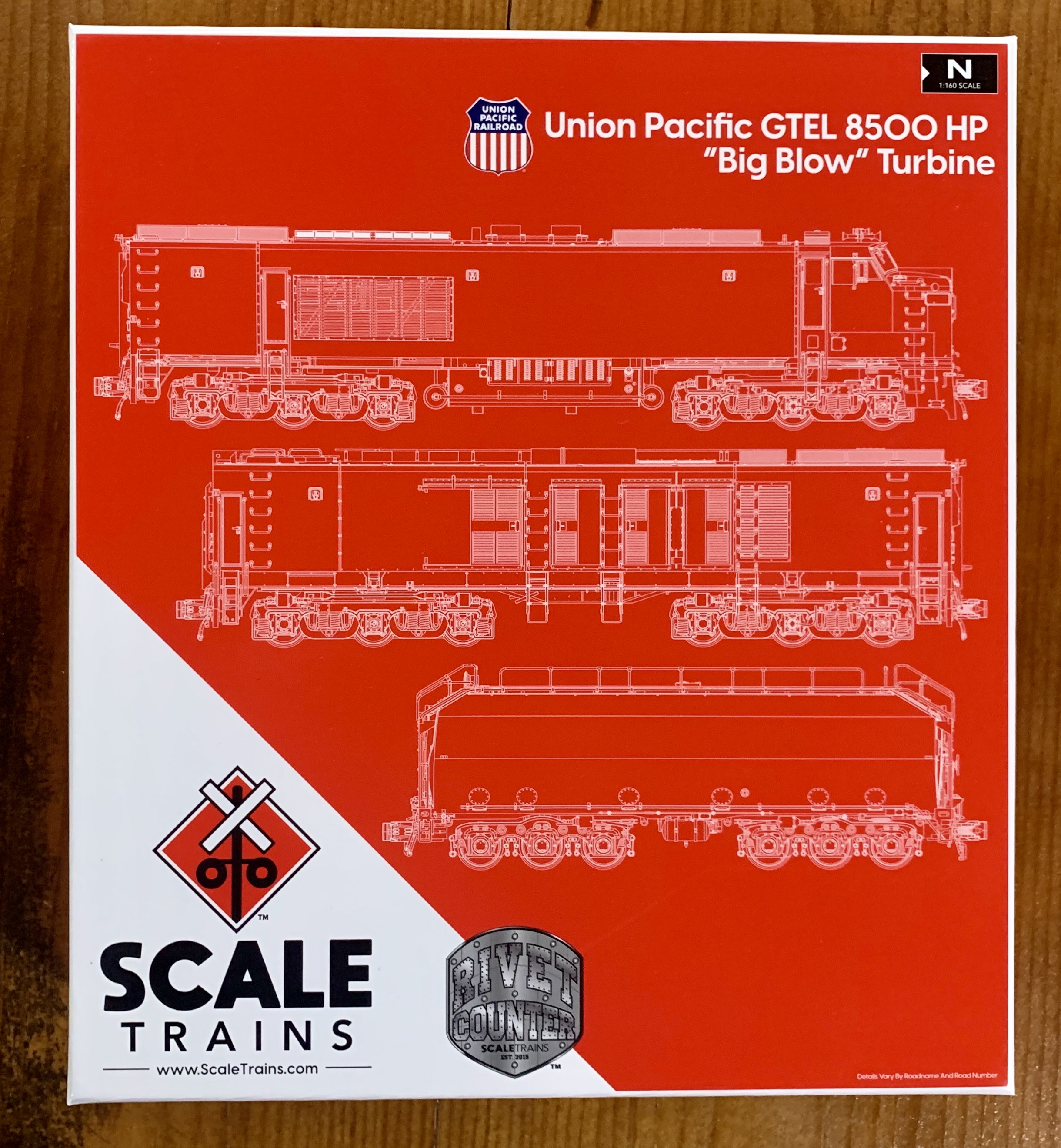
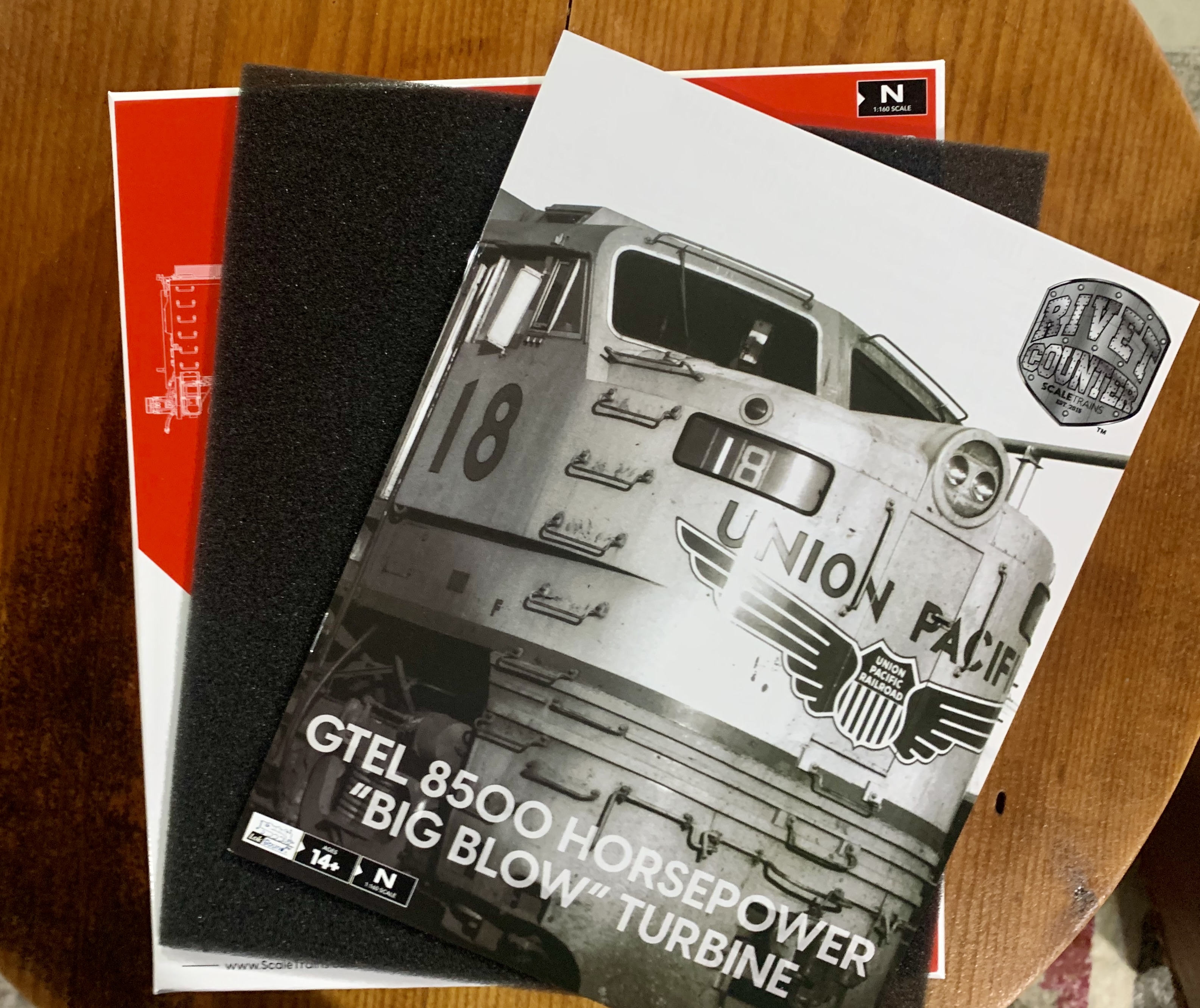
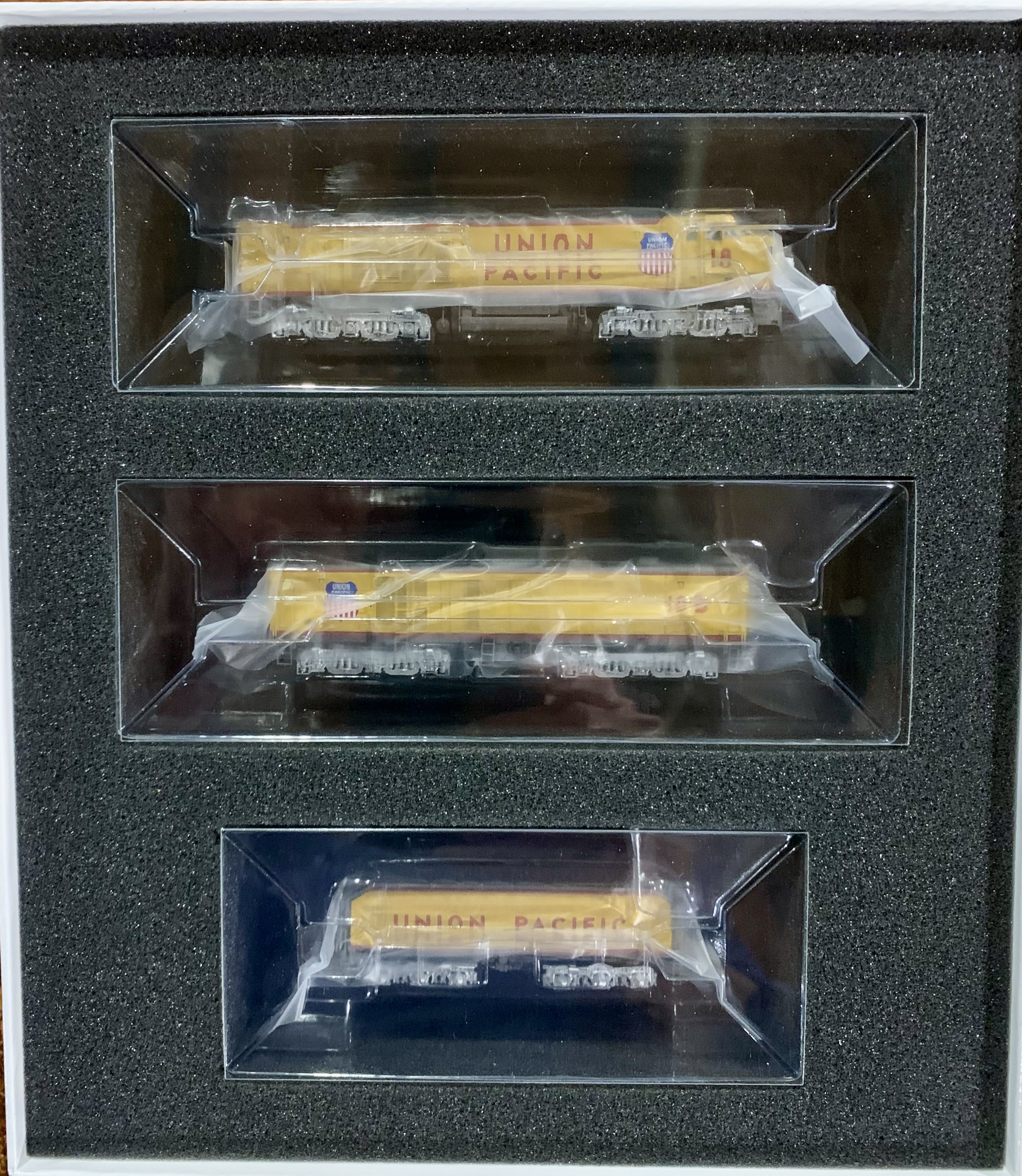
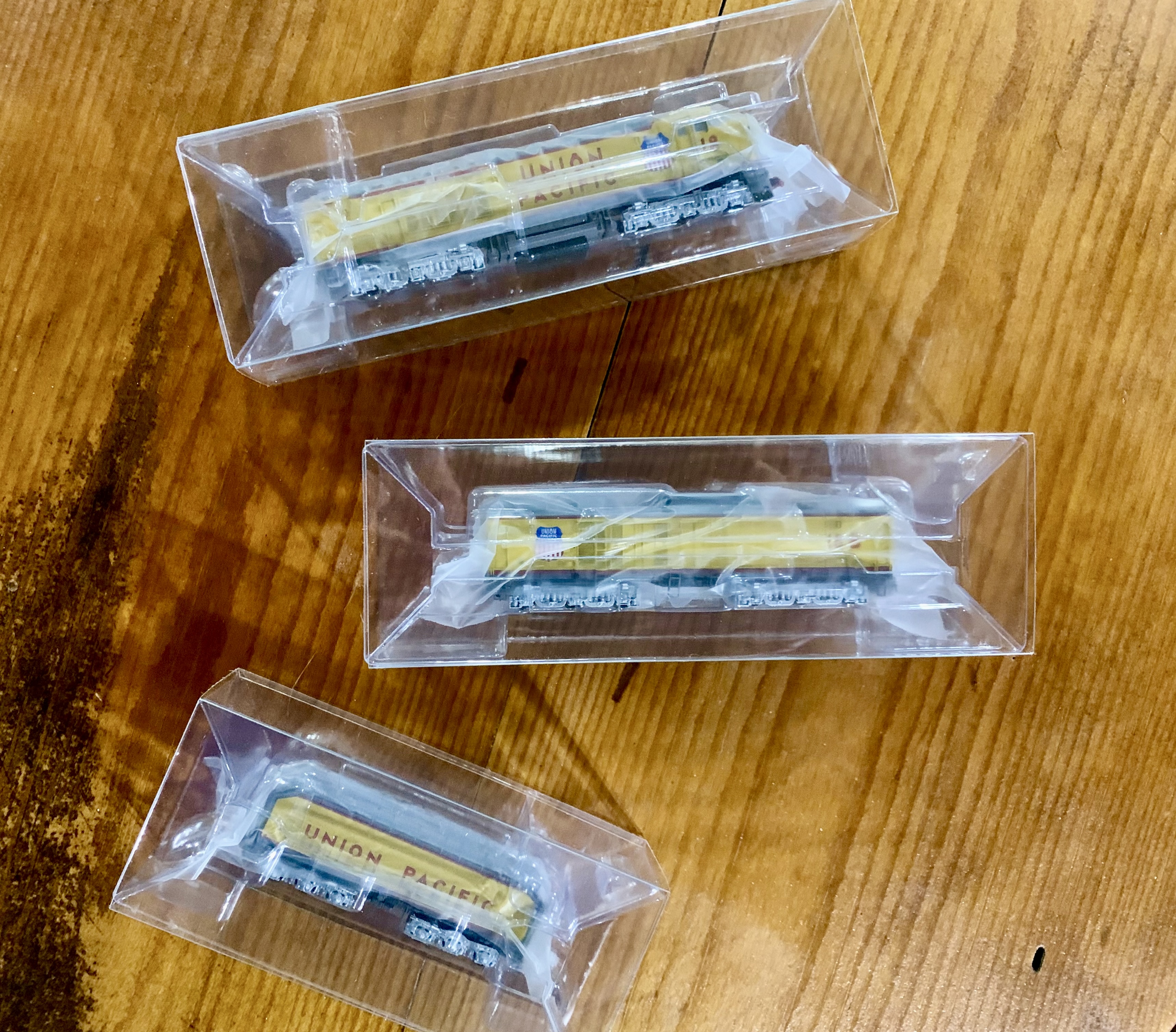
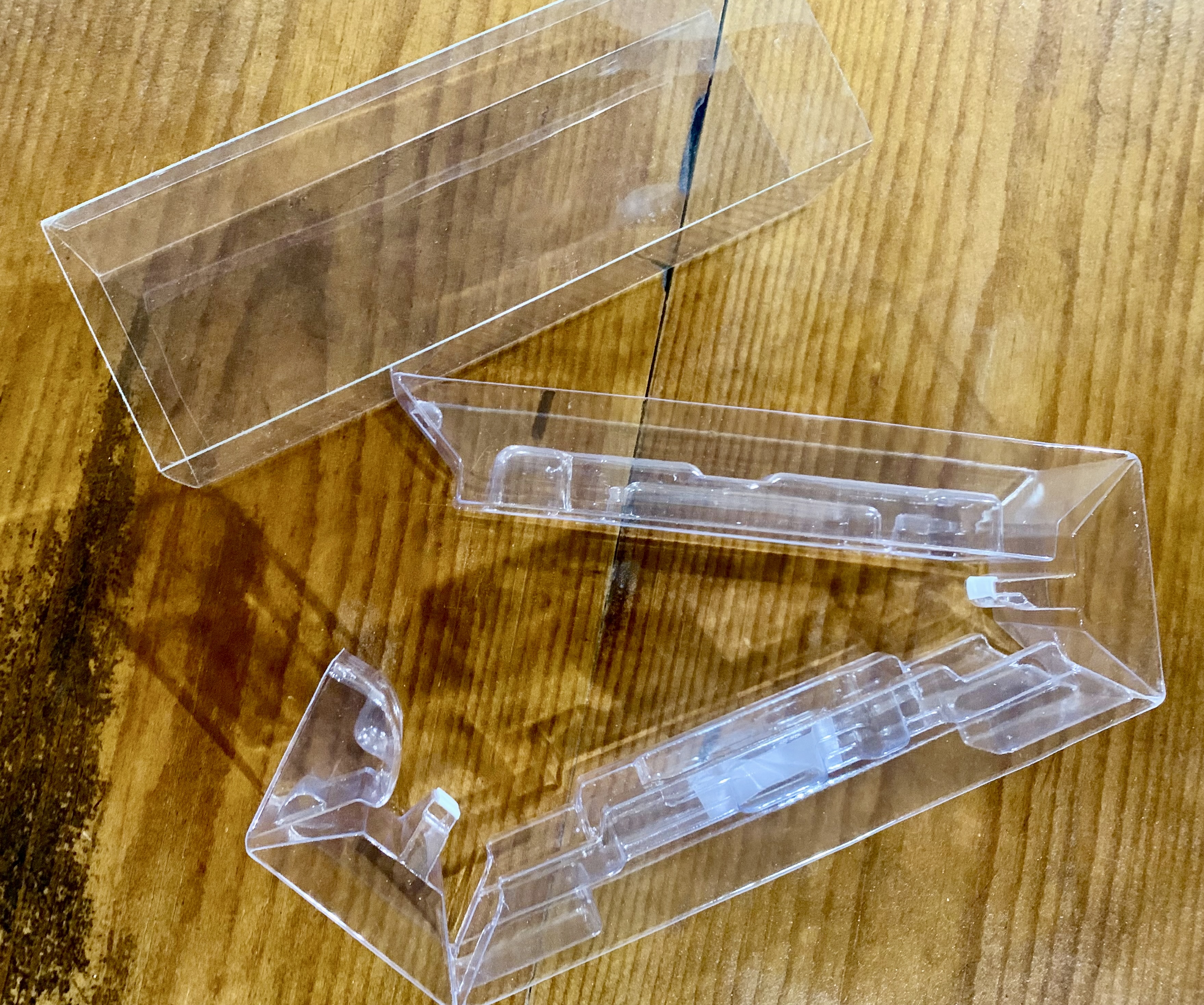
The A-Unit
Union Pacific #18 was built by General Electric in 1960. Both the A and B units were 16-feet tall, 10-feet wide and rode along on General Steel Castings (GSC) trucks. The lead A-unit featured the control cabin and a Cooper-Bessemer diesel engine to handle auxiliary and yard operations without the need to fire up the massive gas-turbine. The ScaleTrains Rivet Counter locomotive arrives either DCC Ready or equipped with an ESC LokSound 5 DCC Sound Decoder. The A-unit weighs a hefty 4.5 ounces and measures 5 inches long.The ScaleTrains turbine collection is so painstakingly thorough with accurate detail work that I cannot list all the ‘bells-n-whistles' that these wonderful models display. I will highlight a few features found on each piece of equipment. The real Union Pacific #18 is a static exhibit found at the Illinois Railway Museum in Union, Illinois. The majestic turbine is prominently displayed in Yard 5 – right smack in the middle of the grounds...one cannot miss this marvel of the railroad. One of the more iconic images from the museum is the front nose of turbine #18 – and ScaleTrains nails it perfectly. The beautiful Union Pacific logo, dual beam headlights, separately applied grab irons, trainline hose, windshield wipers, LED number boards and the green cab hood.
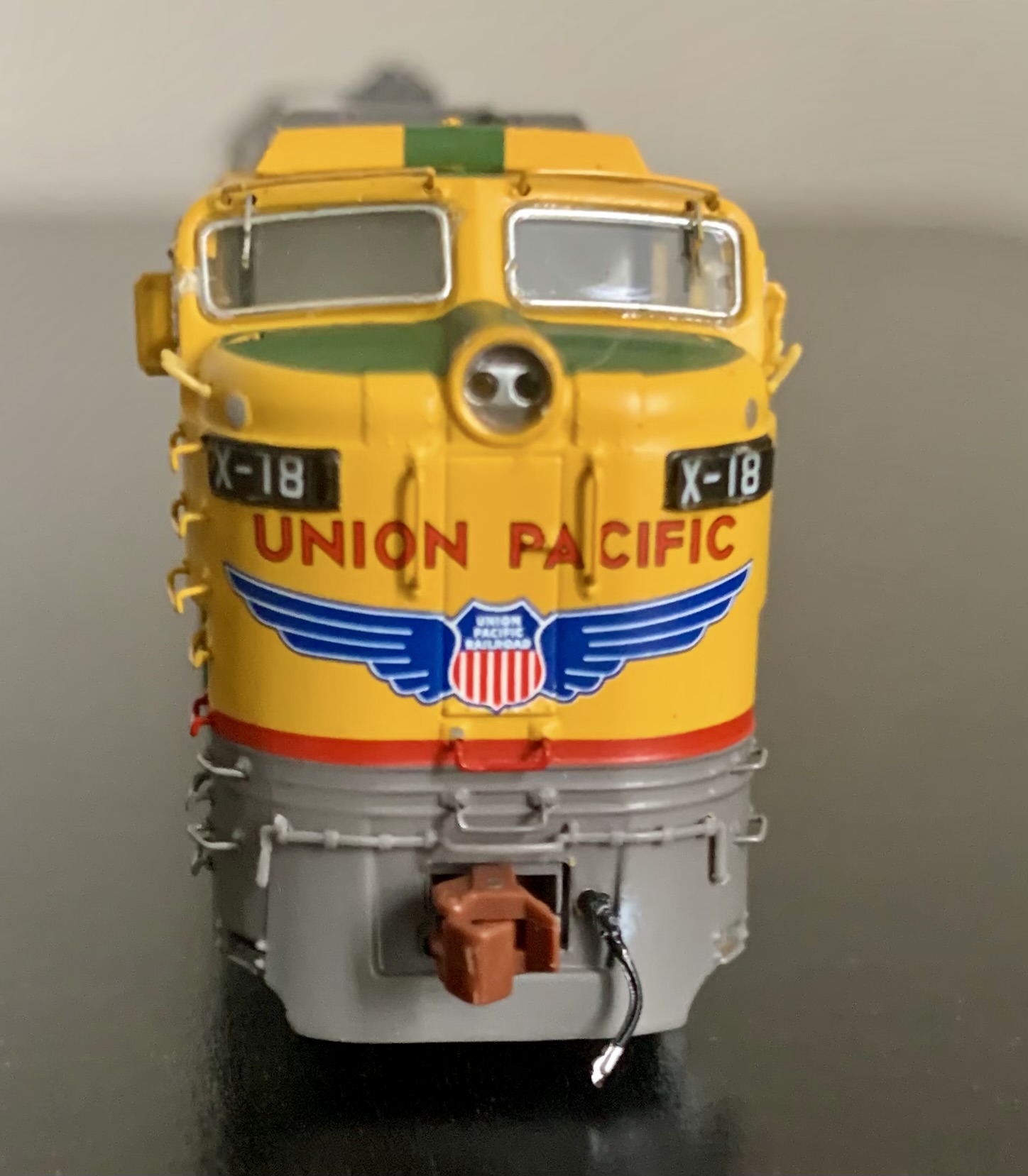

Why the green hood? The practice appears to have started in 1945 when Fairbanks-Morse applied dark green flat paint on the hoods of their FM Erie-Built streamliner diesel locomotives to reduce glare. The Union Pacific ‘borrowed’ this idea and began to use dark green paint in August 1946 on their new E-7 diesels. In May 1951, Union Pacific’s General Superintendent of Mechanical Shop Forces issued a directive that dark green non-skid liquid plastic was to be affixed on the top of the cab hood of all diesel-electric units.
Side features include fine separately applied wire grab irons, photo-etched see through grill, access doors, interior cabin detail with seats, side cab mirrors, and sharp rivet patterns. Rear elements include hose cluster, access door, and platform.
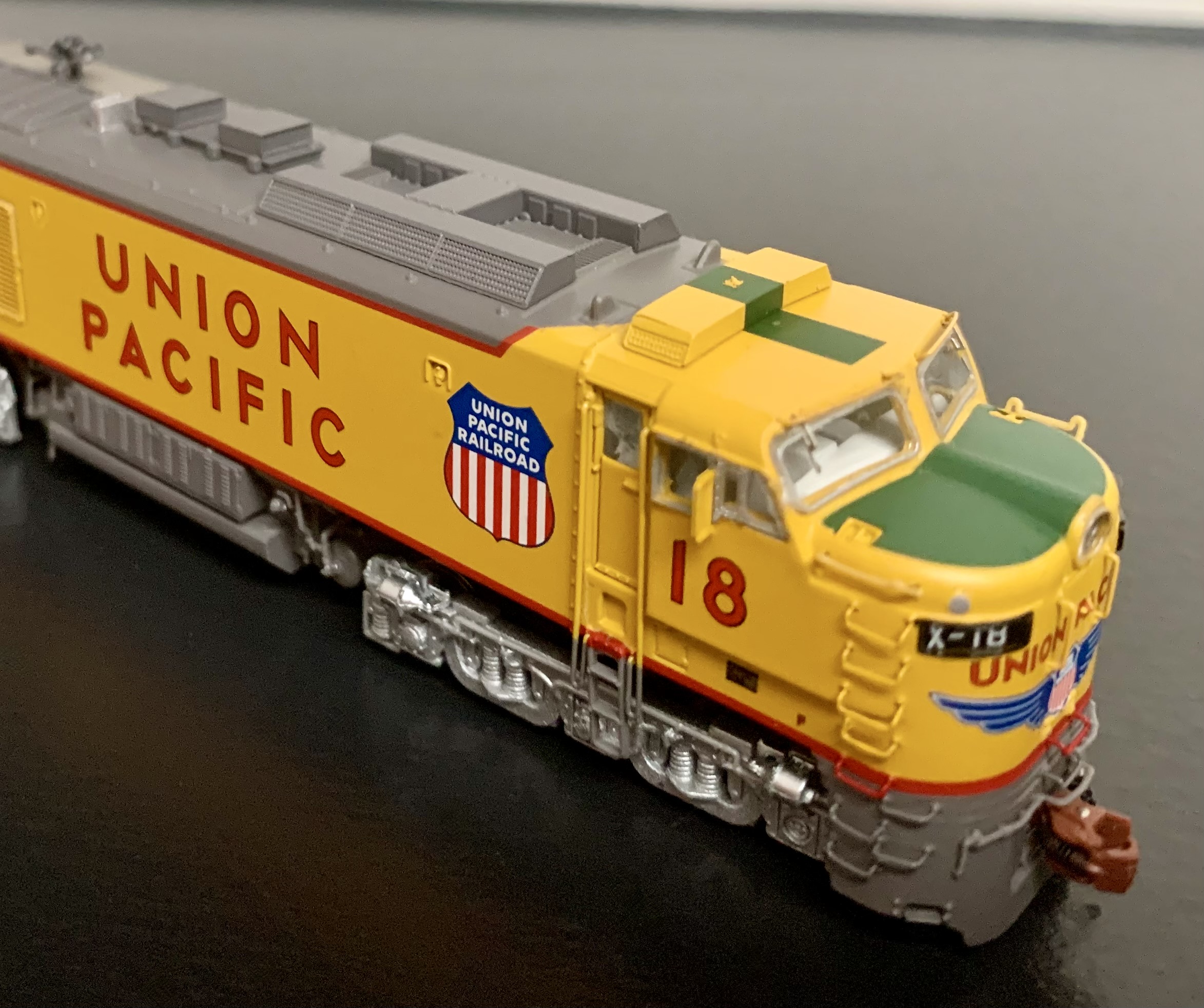
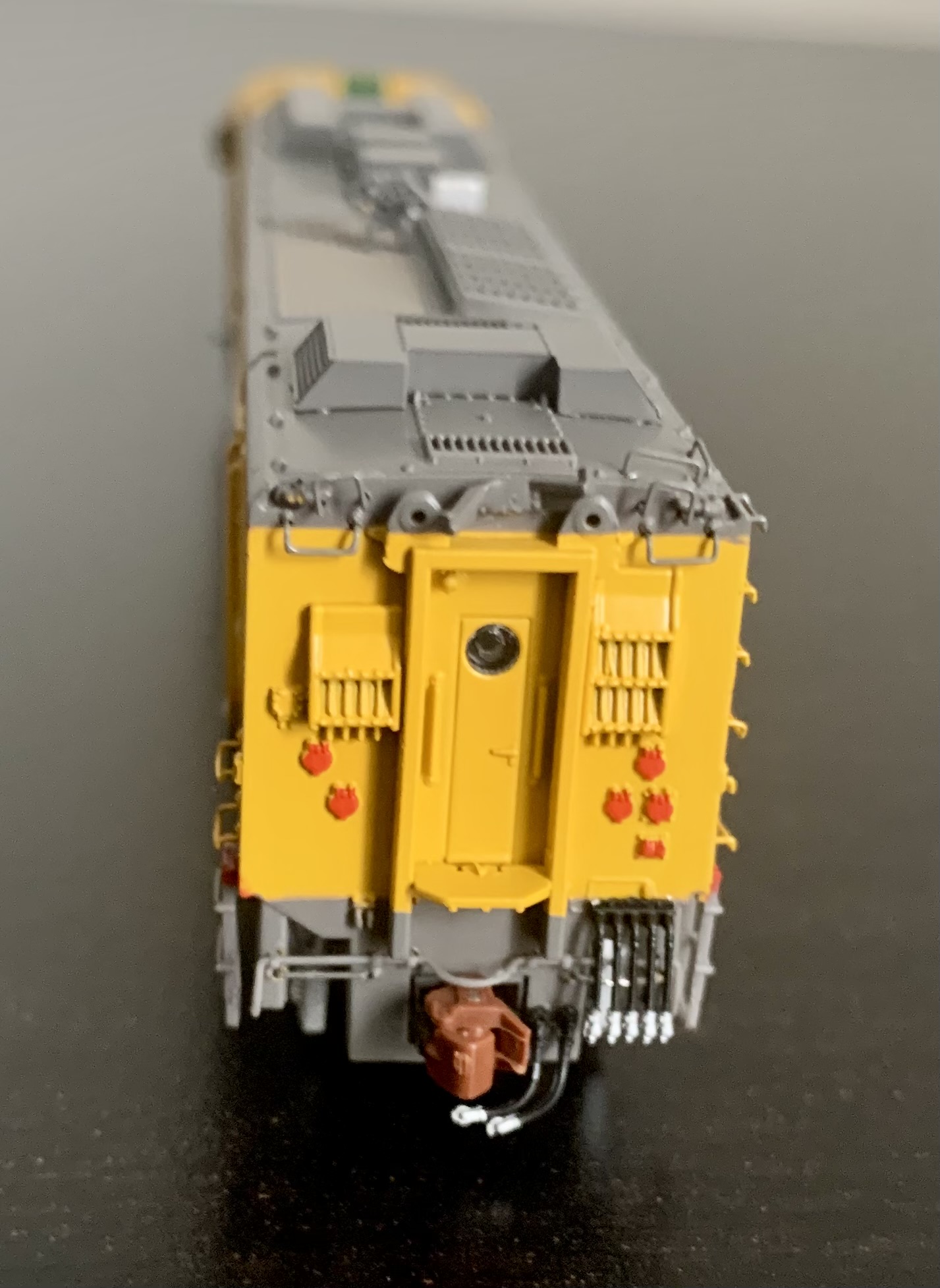
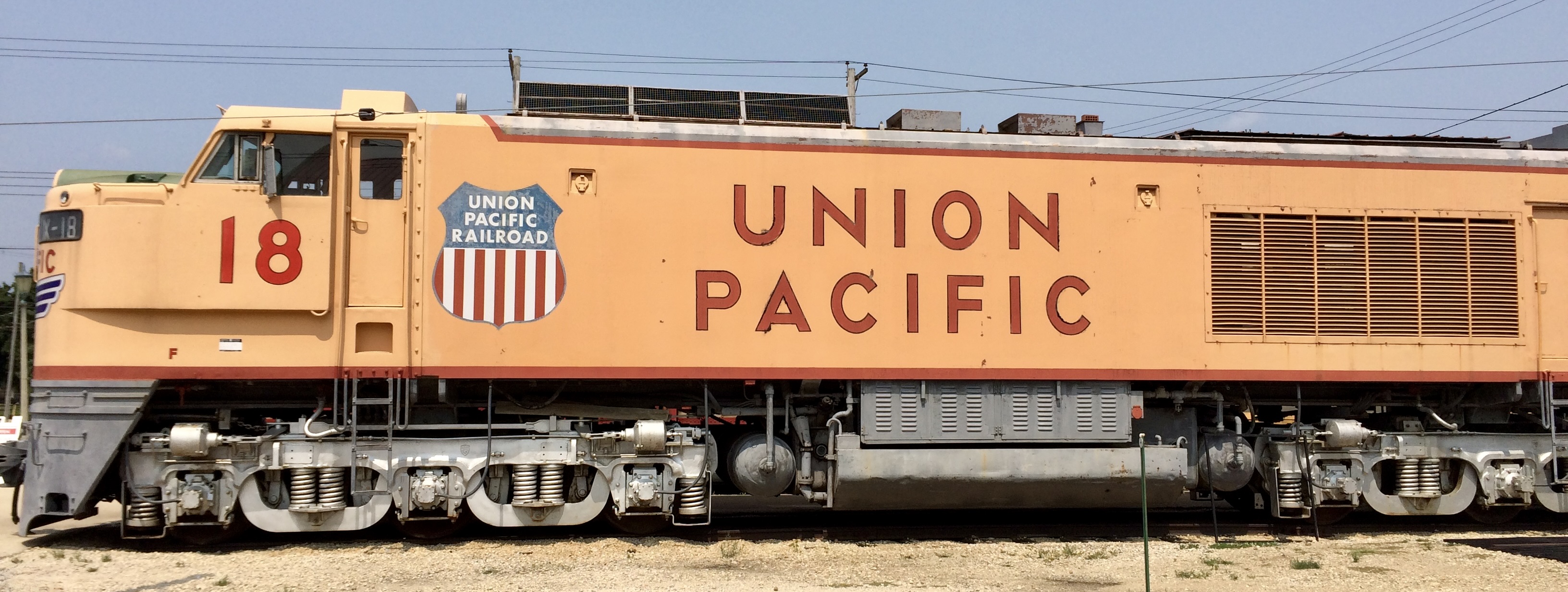
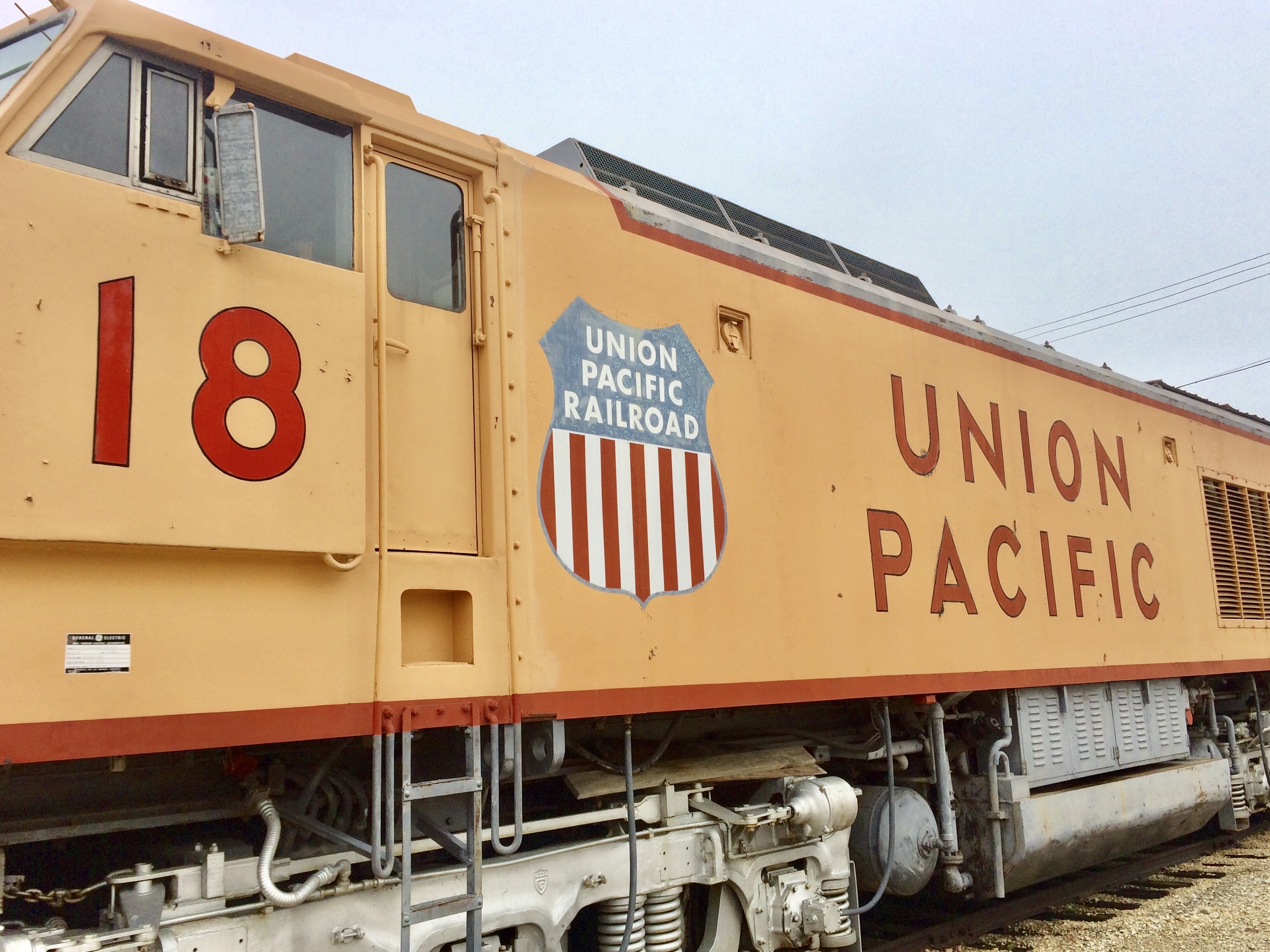
The top and bottom craftsmanship does not disappoint – the most amount of fine detail parts I have seen on a N scale model. Atop you will find a Leslie S-5T-R horn, dynamic brake housing, radiator panels, sand fillers, and cab heater box. The underside components include a finely modeled battery box, fuel tank, dual air tanks, and prototype correct silver trucks.
EA
The B-Unit
Not to be outdone, the B-unit comes-in a tad lighter at 4.2 ounces and 4.5 inches in length. But the amount of detail work is still extraordinary. The prototype B-unit was also built in 1960 by General Electric and carried the powerful 8500 horsepower super gas-turbine and generators. Multiple columns of hand applied wire grab irons, boldly colored Union Pacific logo shield, sharply detailed rivet lines and louver turbine doors. Above we discover photo-etched walkways, dynamic brake housing, dynavane intake housing, air scoops, and an intricate turbine exhaust portal (non-operating) with more end-of-unit hose clusters.

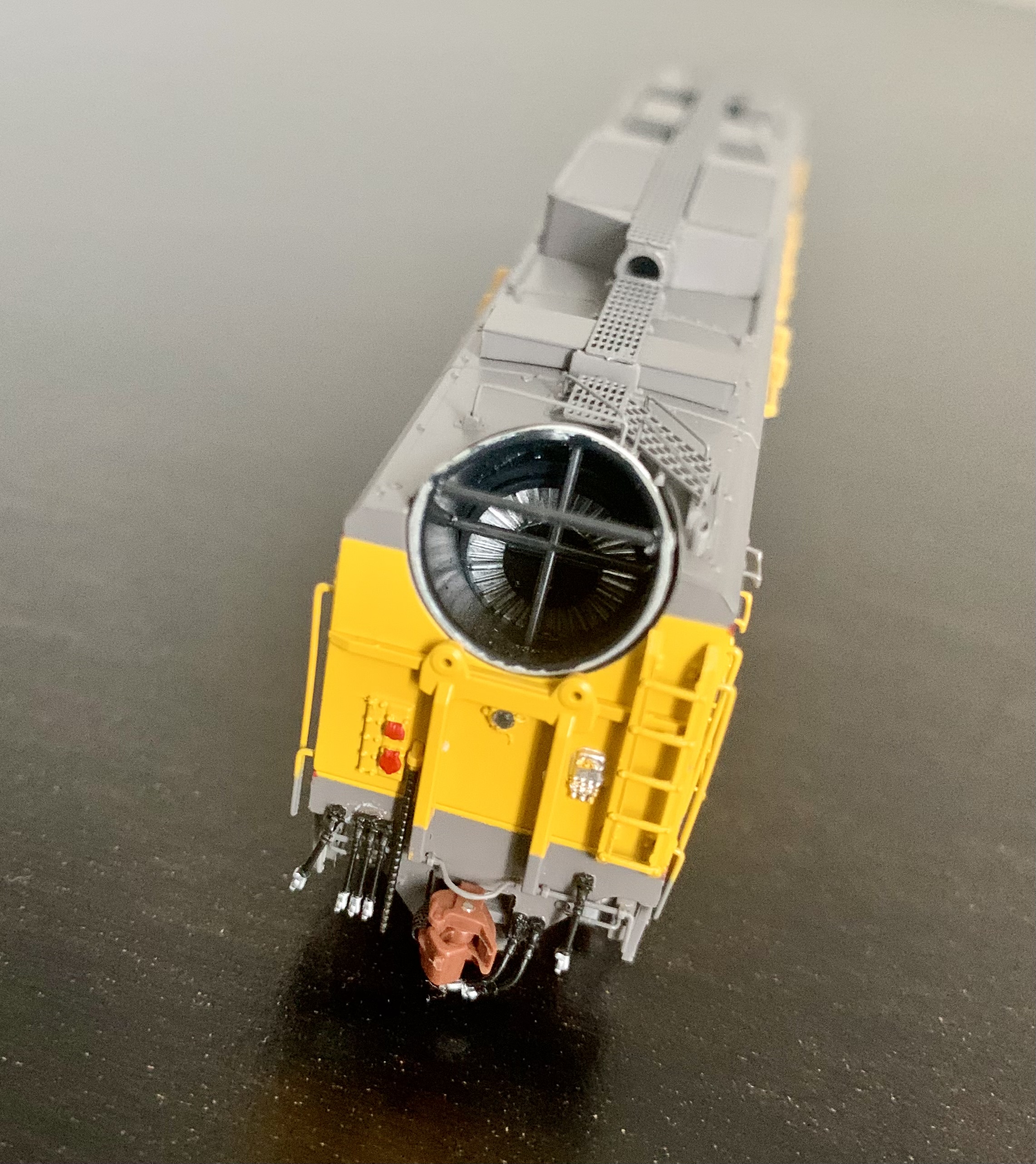
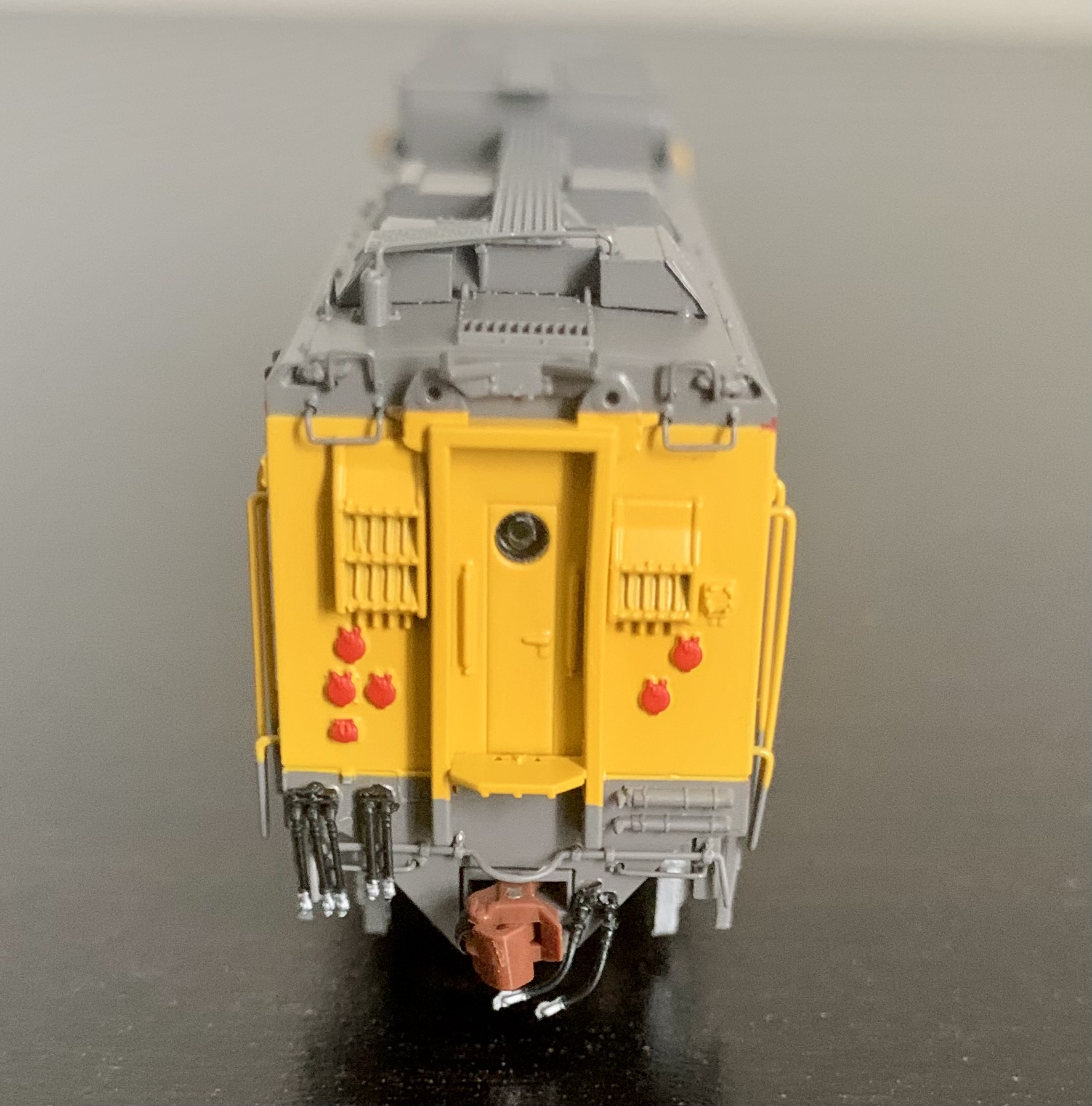
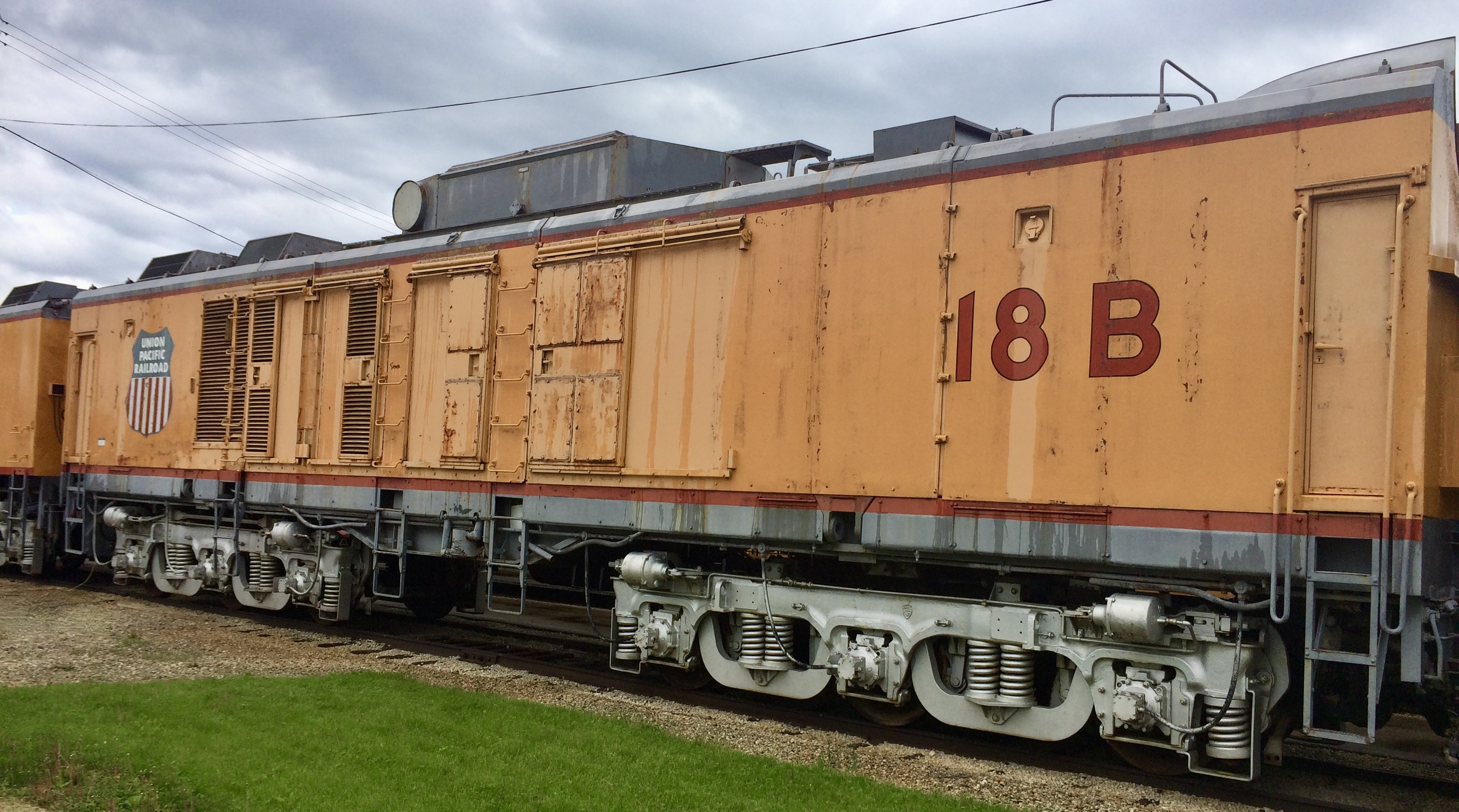
Fuel Tender
Finally, the old man of the group. Union Pacific Fuel Tender #18 lived a long life on the rails. The 24,000-gallon unit was built in 1937 for the FEF stream locomotive series. Although road worn and peeling today, the ScaleTrains model shows him during his heyday in the groovy 1960s. Large Union Pacific name is emblazed on both tender sides. Tender details consist of separately applied deck handrails, photo-etched walkways, electrical conduit along bottom, fuel hatch, Miner brake wheel, and plumbing connections at unit end. Tender runs on silver Commonwealth 6-axle trucks. One distinctive feature is a functioning rear-facing LED headlight that glows while running in reverse.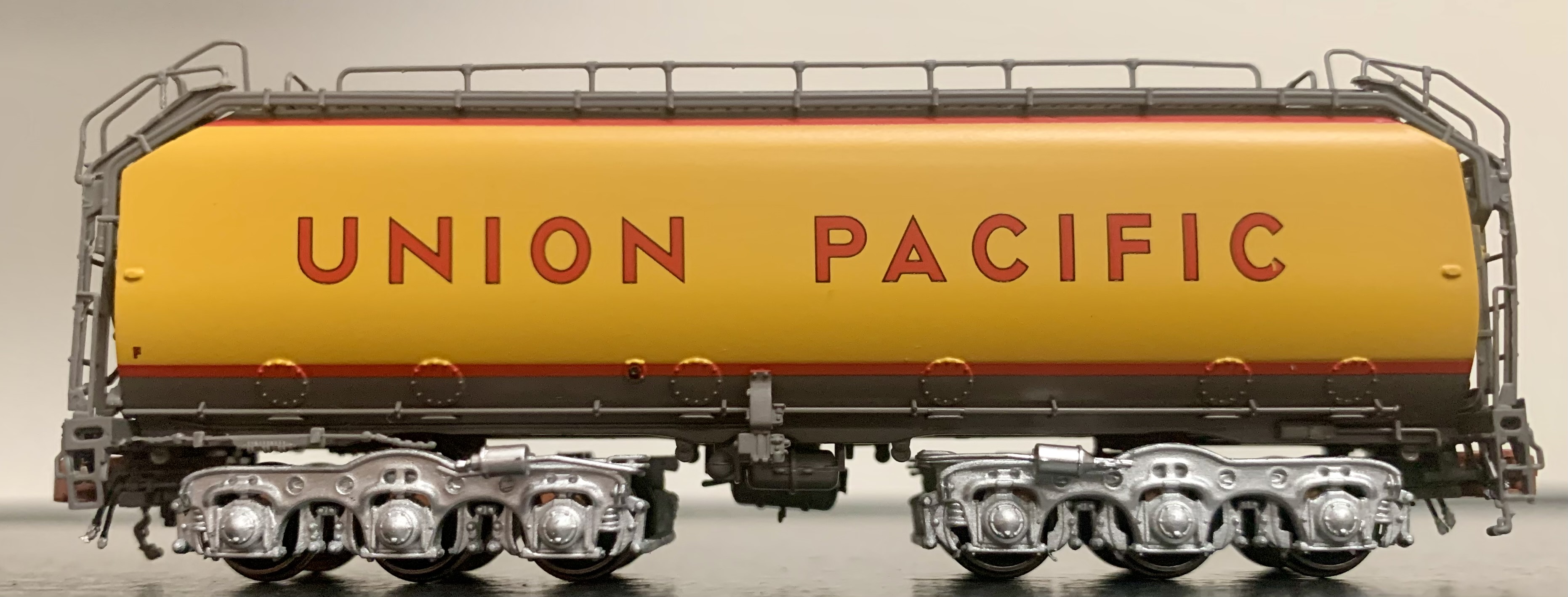
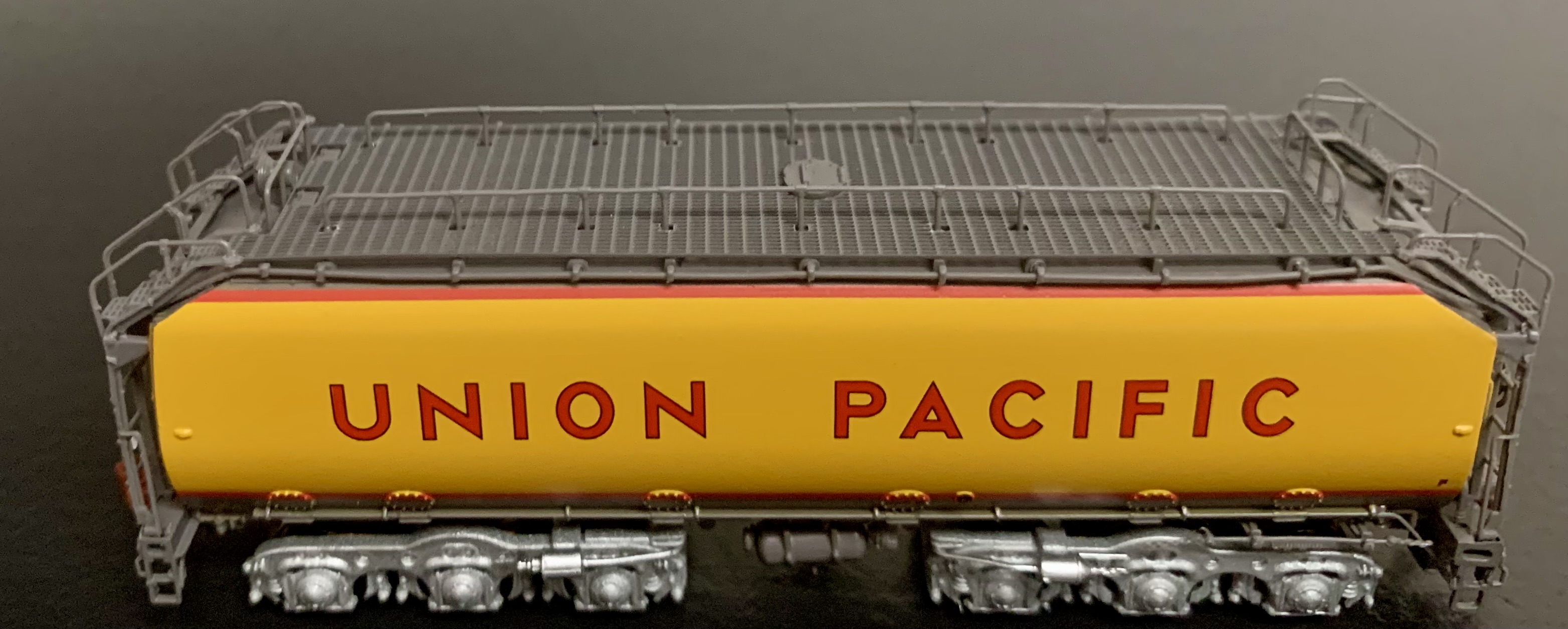
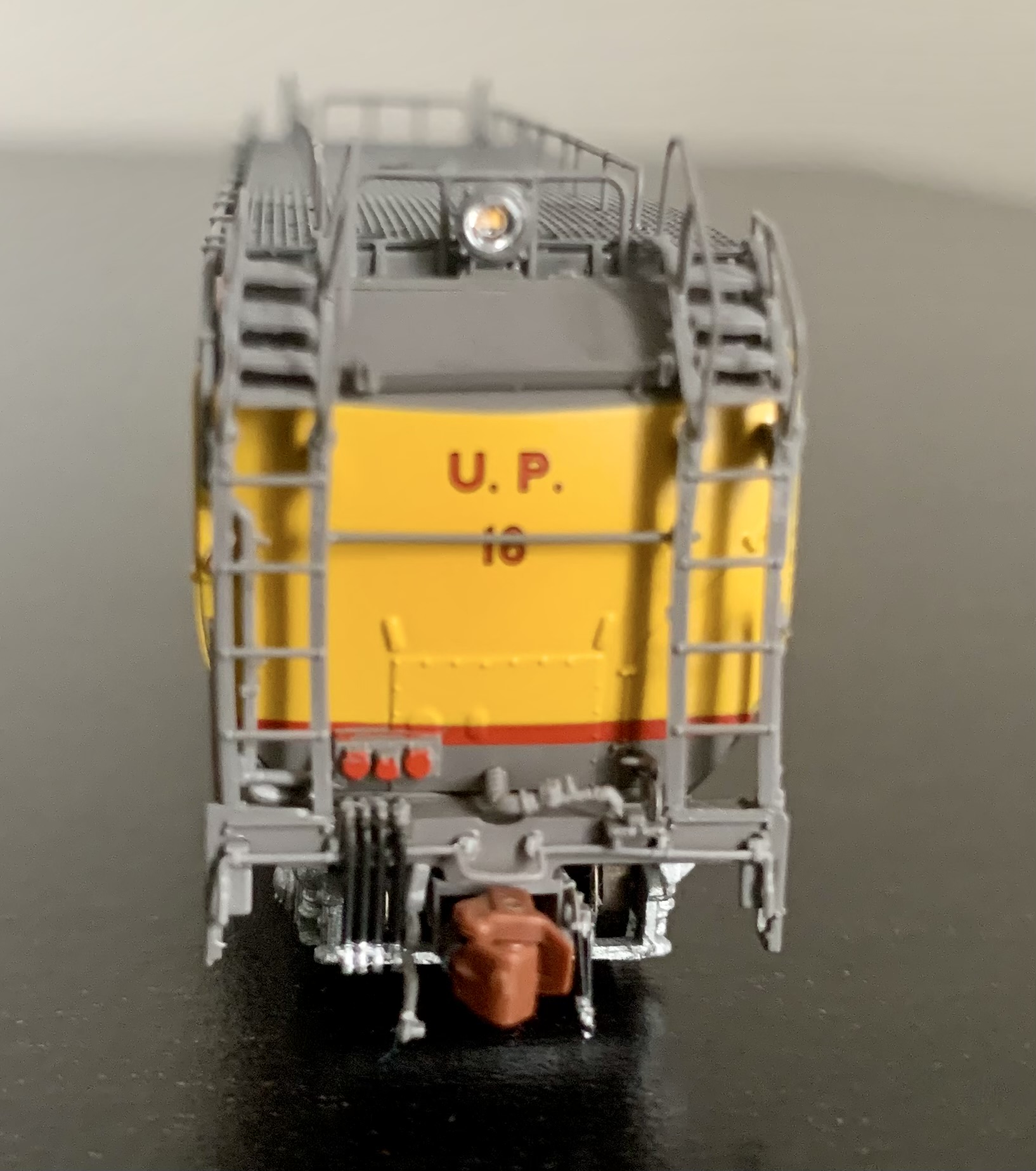
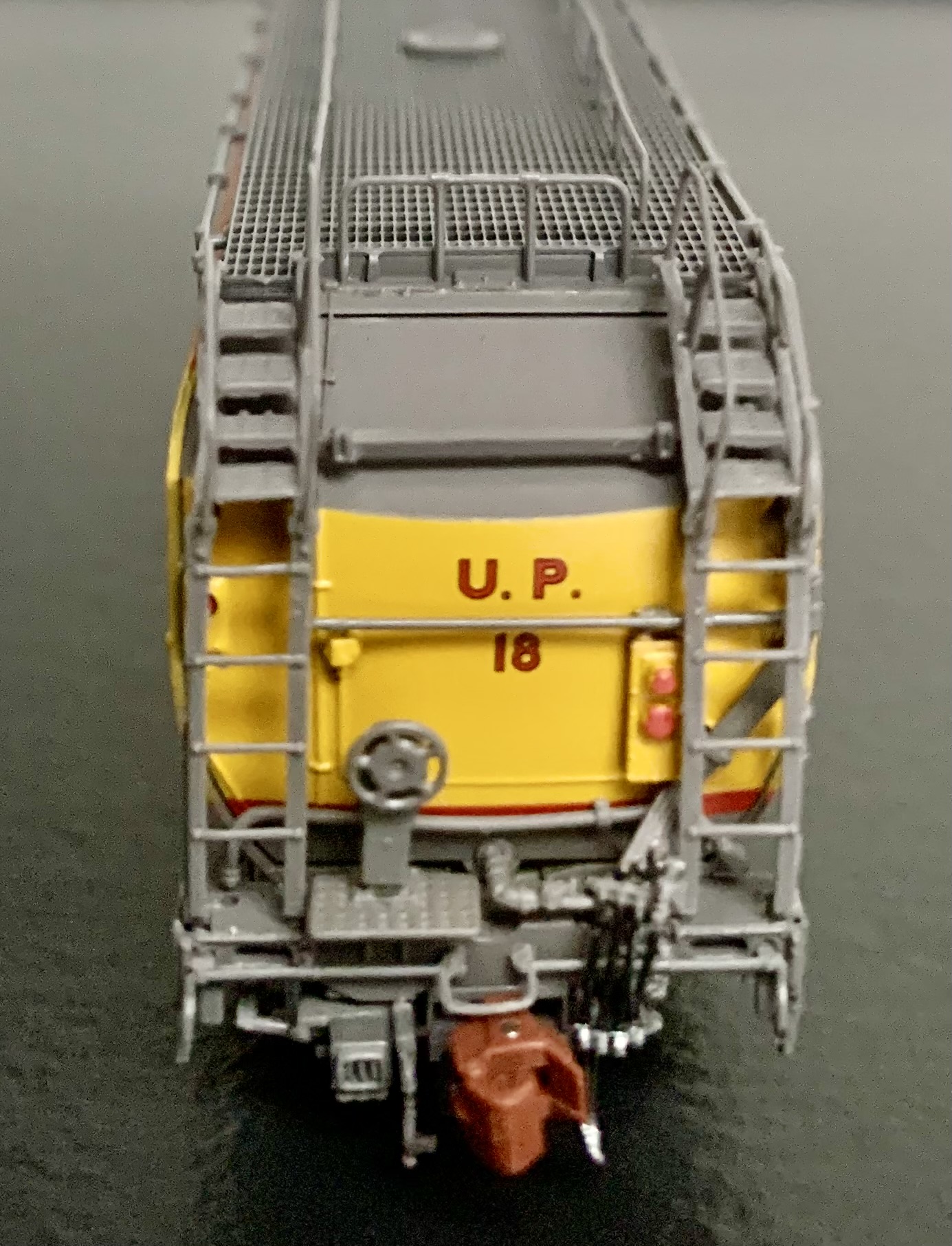
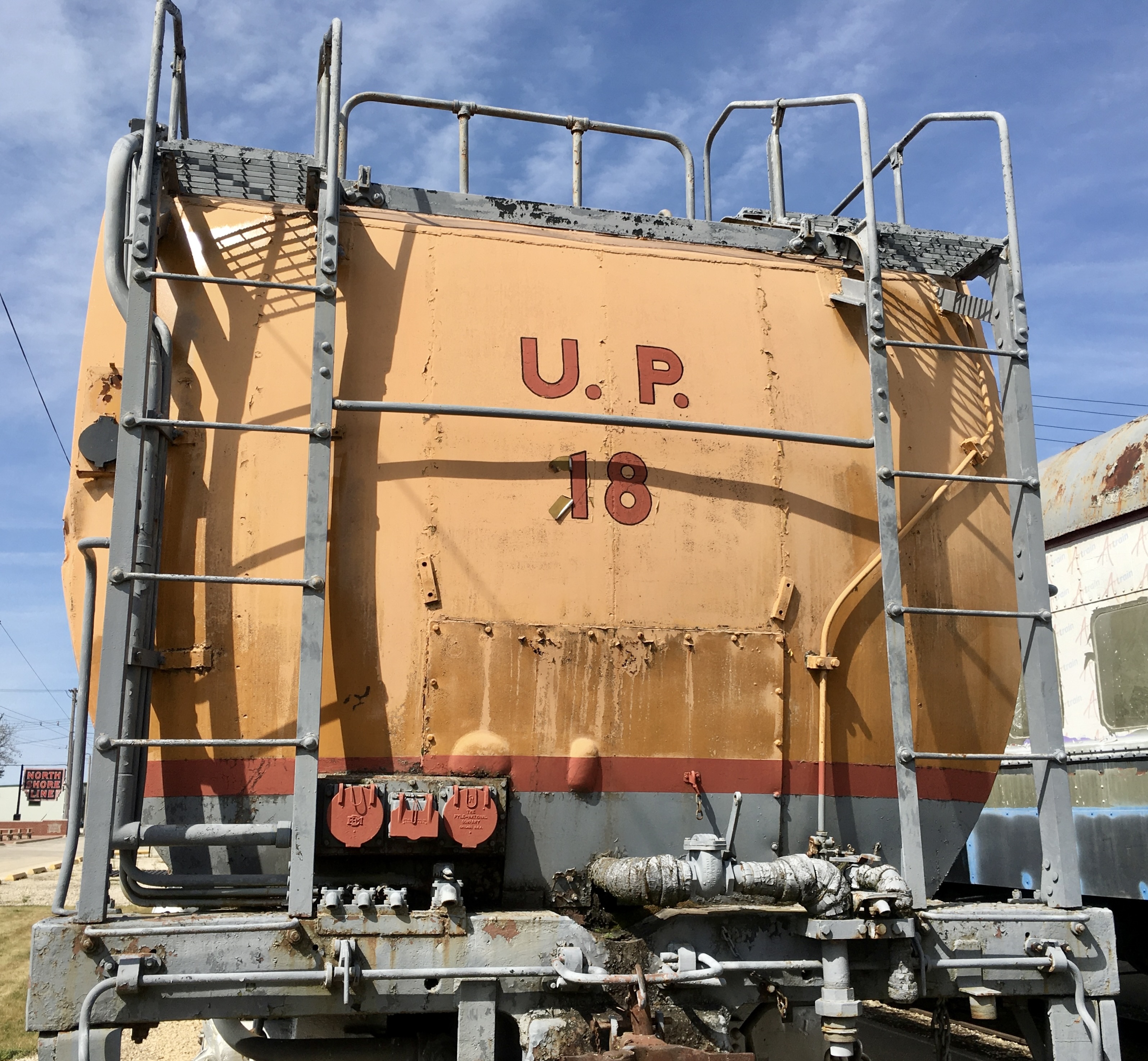
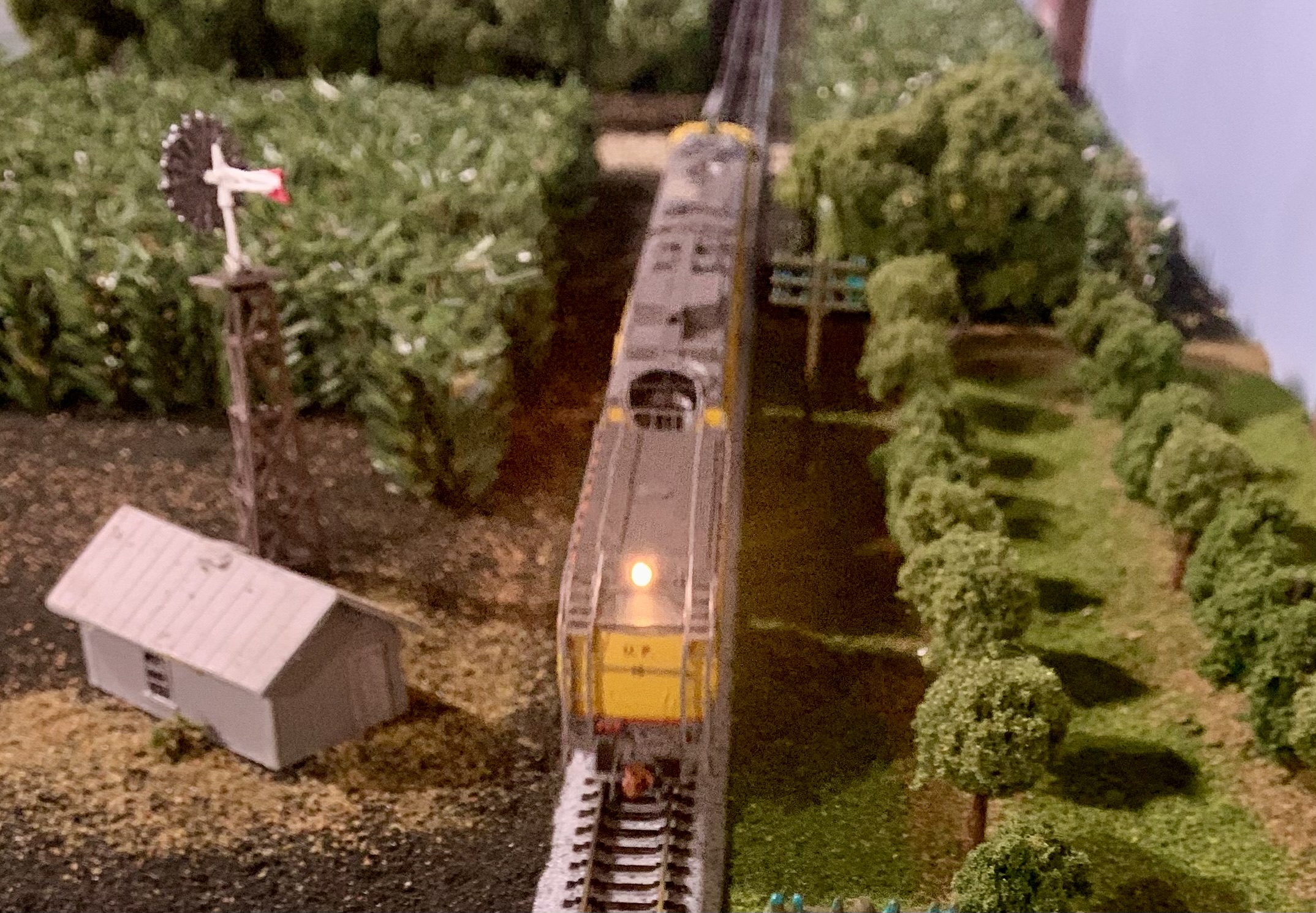
All three units are supplied with brown Semi-scale Type E Micro-Trains Line compatible knuckle couplers. If you desire to replace the ScaleTrains couplers with a Micro-Trains product, a specific coupler centering spring is required from ScaleTrains to accept this swap. All couplers were measured to the correct height, and I had zero issues while running on Kato Unitrack at low and medium speeds around curves and through turnouts. The minimum operating radius is 11”.

DDC/Sound version features high-quality LokSound 5 noises: GE bell, Leslie S5T-RF horn, turbine, hostler motor, dynamic brakes, sanding valve, radiator fan, and curve squeal to name a few. If you wish to hear a different horn or bell sound – several varieties of Nathan and Leslie horns are made available (CV9) and an EMD air bell (CV10) is also included.
Conclusions
In closing, I am not a guy with a large budget for model trains. Always dreaming to have the latest and best but never winning the lottery. This was my splurge – and incredibly happy to have been able to purchase this set. The Union Pacific turbines have a special place in my heart (like many of you that adore the Big Boys and other famous trains). As a long time member of the IRM, I have visited Union Pacific #18 dozens of times and I am always taken aback by the sight of that mighty three-piece lineup.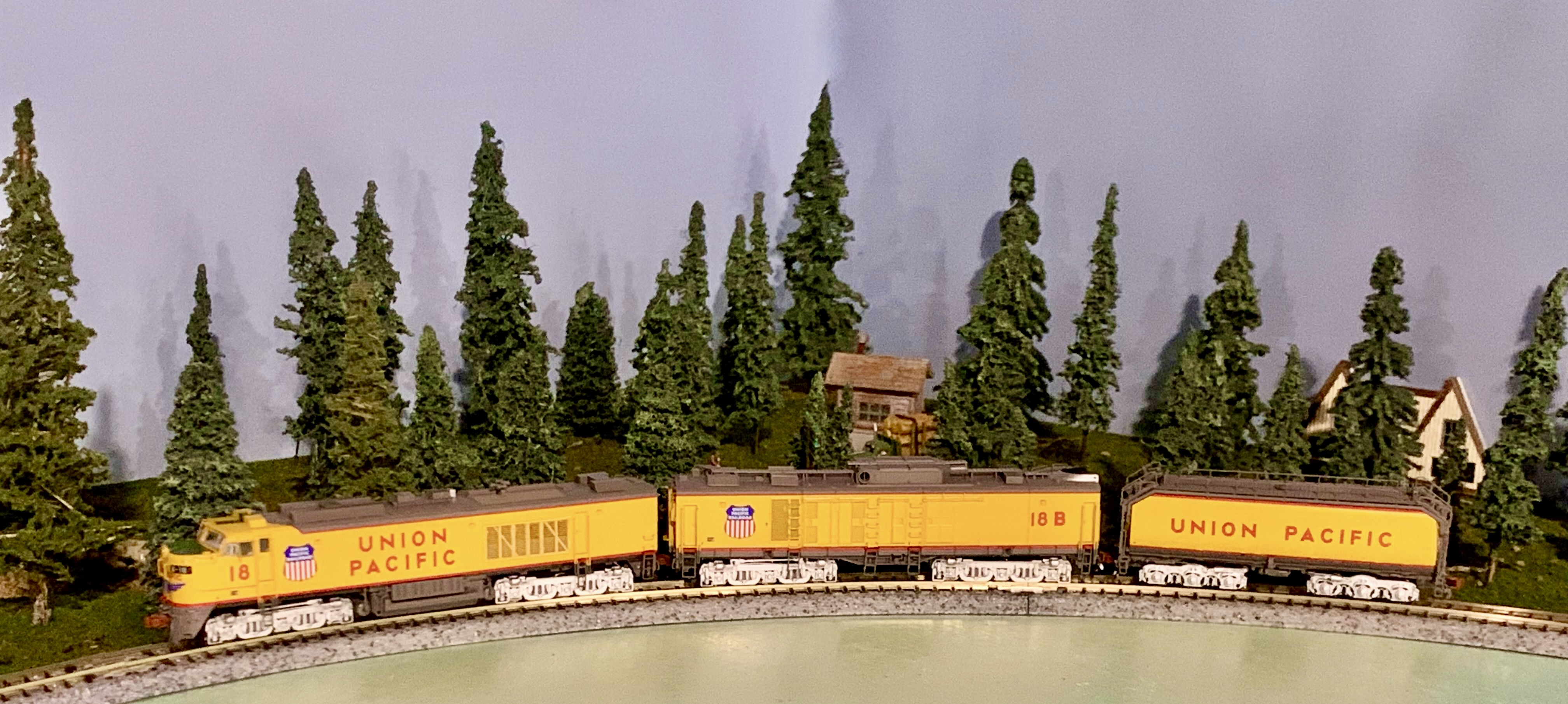
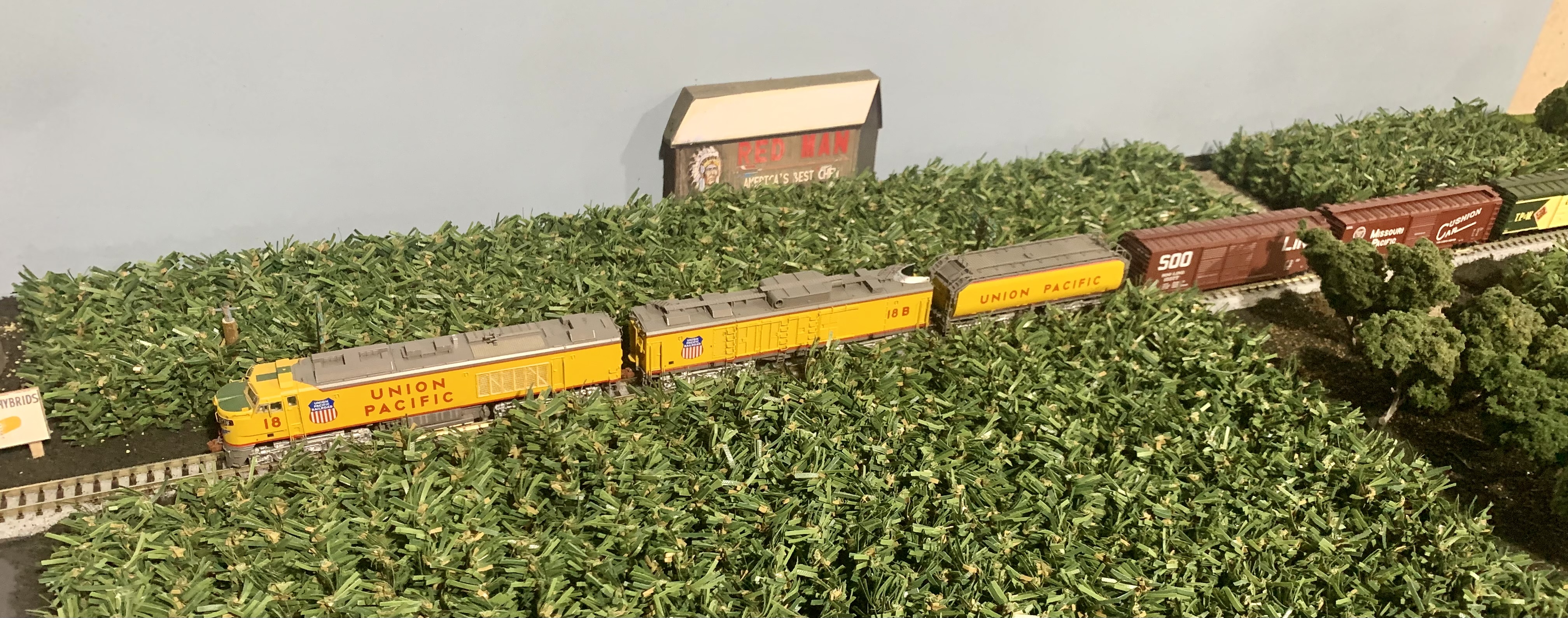
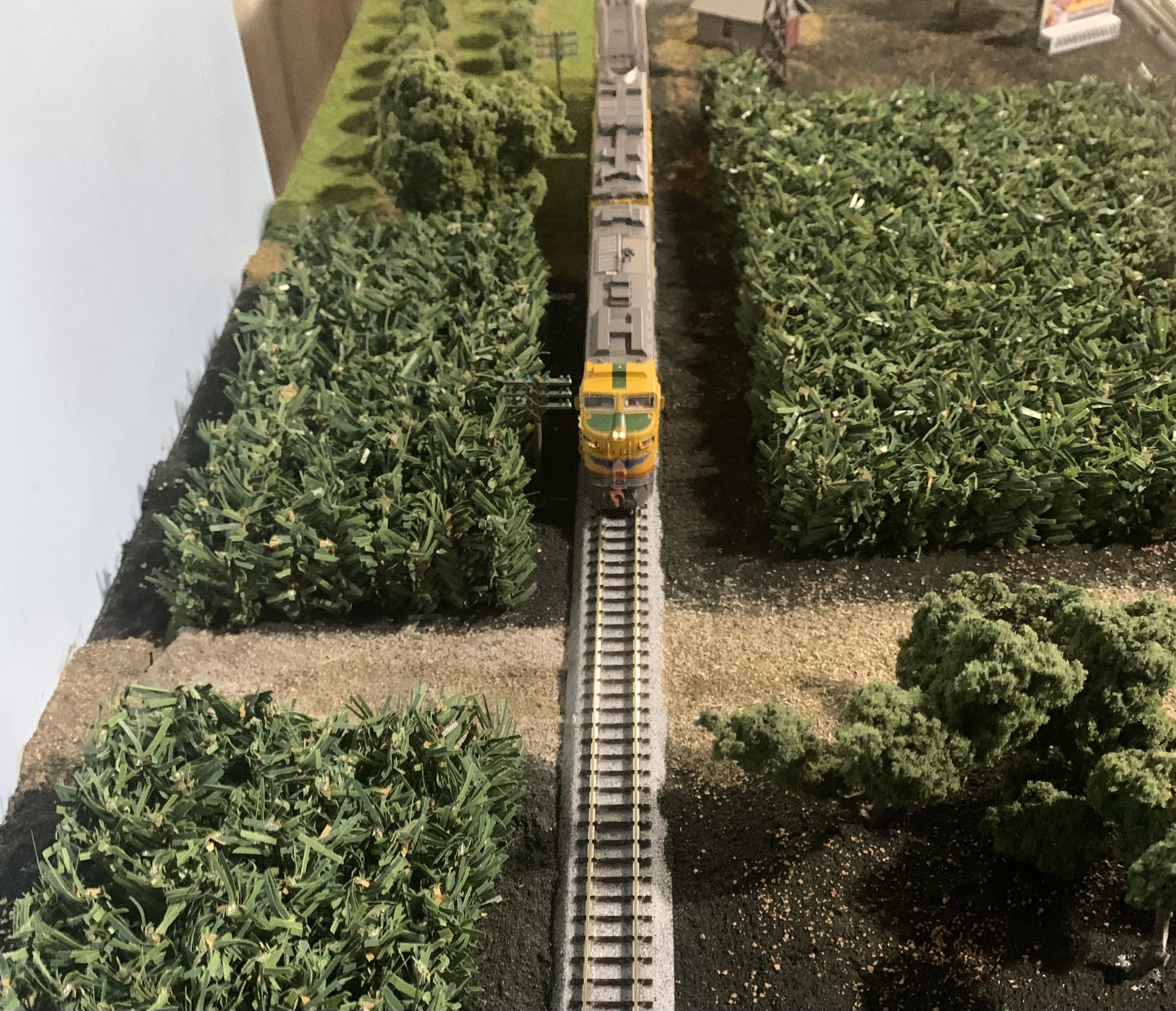
ScaleTrains has created a near perfect representation of the Union Pacific Gas-Turbine Electric Locomotives (GTEL). Flawless craftsmanship, gads of hand-applied fine detail parts, clear and bold colors, and an excellent running three-piece consist that needed no adjustments to run impeccability. This may be a once-in-a-lifetime purchase...I highly recommend saving those extra pennies and indulging in a ScaleTrains Union Pacific GTEL “Big Blow” Turbine if the opportunity arises.
To see a list of all cars in this series, CLICK HERE

